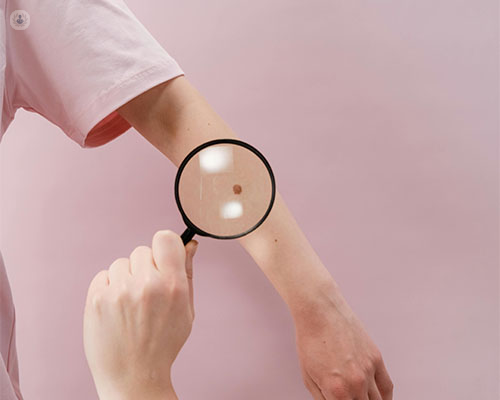Reconstructive surgery for skin cancer: techniques and recovery process
Escrito por:Skin cancers manifest in the form of red bumps, angry moles, or discoloured patches, and the most effective treatment for them is to remove them as soon as possible so that they cannot metastasise and spread to the rest of the body. The three most common kinds of skin cancer are basal cell carcinoma, squamous cell carcinoma, and melanoma – and around 20 per cent of the population will get some form of skin cancer in their lifetime. We spoke to a leading consultant plastic surgeon about what comes next after skin cancer is removed.

Although treatments like laser and cryotherapy are minimally invasive and highly effective for maintaining the aesthetic integrity of the skin, they are only suitable for cancers that are superficial like some kinds of basal and squamous cell carcinomas. Most surgical solutions for skin cancer will either be an excision of the affected area or Mohs surgery, which is a precise procedure in which the only infected tissue is painstakingly removed and thin layers of surrounding tissue are methodically sliced off and examined under a microscope until cancer stops appearing in the skin cells. Both of these techniques have high success rates and are industry standard, but although they will remove the cancer, what can be left behind is a visible craterous mark or deformation of the area. This is simply unavoidable as of course a portion of skin that ranges from the epidermis (surface) to the dermis (the thick underlayer) has been removed, however, there are methods of cosmetic reconstructive surgery that can help minimise the visual disruption to the appearance.
What are the reconstructive surgery options for skin?
The two most common procedures in cosmetic reconstruction for skin cancers are skin grafts and skin flaps. They are similar in that a patch of skin in “donated” from another part of the body to cover the wound left behind from the removal. The key difference between the two methods is that in a skin graft, the donor patch is taken from somewhere else on the body and has no blood supply, whereas in a skin flap, the tissue is transferred from a neighbouring site to the wound and it brings its own blood supply. The donor skin is selected to match the colour, hairiness, and thickness of the original skin of the recipient area.
These reconstructive surgeries are beneficial not only for aesthetic purposes but can actually hasten the healing process after the removal due to the replacement skin acting as a natural bandage that doesn’t have to be changed or removed, but will hopefully integrate into the placement site.
Skin grafts
There are two kinds of skin graft: the full-thickness and the split-thickness. The full-thickness graft takes the epidermis and the dermis, including hair follicles which is preferable for grafts in places where hair is expected to grow. Split-thickness grafts only take from the epidermis and a portion of the dermis, but there will be no hair growth at the placement site. All skin grafts will contract, meaning that the skin will “shrink” slightly once removed from its original location, so when attached to the placement site, it will feel tight and tender like a graze or burn as it heals for about two months. Skin grafts are a popular and safe option, and are especially useful for when a large patch of skin needs to be replaced, but in full-thickness grafts leave behind a secondary surgical site that will need to be sealed with stitches as well.
Skin flaps
Skin flaps are when the donated tissue is transferred from a neighbouring site, which works to reduce the number of surgical sites as well as promote healing due to the skin cells coming from nearby. Skin flaps are still connected with their original blood supply, so the piece of skin that is selected is stretched, rotated, or shifted to cover the desired defect. The expert surgeon will be able to manoeuvre the piece of skin in such a way so that it may integrate into the area without too much disruption and stitch together any areas that are left uncovered. There are many kinds of skin flaps, which are determined by their composition of tissue, the location of origin, and how its been manipulated to fit the placement site. They are better for facial and smaller wounds.
Aftercare for reconstructive surgery
Both procedures are performed under general anaesthetic, and patients should be able to go home within a day. It is possible that the donated piece of skin can be rejected by the body, but the chances are quite low. The donated skin would have been secured to the wound with stitches, which should be removed by the doctor within two weeks post-surgery, but some patients will have dissolvable stitches that will be absorbed by the body within two months. The wound or wounds will be dressed to minimise exposure. Patients are advised to keep the donor and recipient sites clean and dry. Any lingering pain can be managed with painkillers. While the patch heals, patients are encouraged to avoid strenuous activities until notified by the doctor in order to avoid stressing the site and stretching the skin. Scarring is inevitable, but with vigilance and care in applying strong suncream, pigmentation will be reduced.
If you are concerned about a mole or would like to know more about reconstructive surgeries for the skin, book an appointment with a specialist via Top Doctors.


